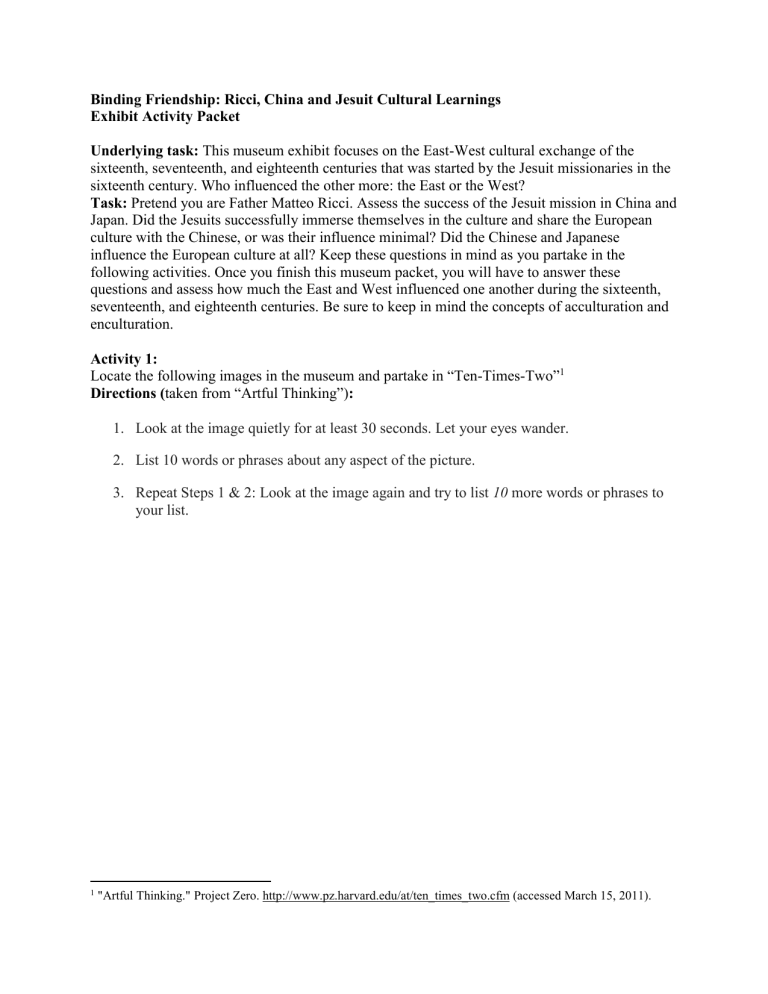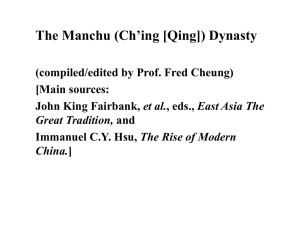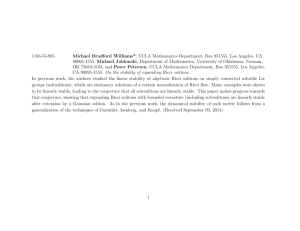Museum Activity Packet

Binding Friendship: Ricci, China and Jesuit Cultural Learnings
Exhibit Activity Packet
Underlying task: This museum exhibit focuses on the East-West cultural exchange of the sixteenth, seventeenth, and eighteenth centuries that was started by the Jesuit missionaries in the sixteenth century. Who influenced the other more: the East or the West?
Task: Pretend you are Father Matteo Ricci. Assess the success of the Jesuit mission in China and
Japan. Did the Jesuits successfully immerse themselves in the culture and share the European culture with the Chinese, or was their influence minimal? Did the Chinese and Japanese influence the European culture at all? Keep these questions in mind as you partake in the following activities. Once you finish this museum packet, you will have to answer these questions and assess how much the East and West influenced one another during the sixteenth, seventeenth, and eighteenth centuries. Be sure to keep in mind the concepts of acculturation and enculturation.
Activity 1:
Locate the following images in the museum and partake in “Ten-Times-Two”
1
Directions ( taken from “Artful Thinking”)
:
1.
Look at the image quietly for at least 30 seconds. Let your eyes wander.
2.
List 10 words or phrases about any aspect of the picture.
3.
Repeat Steps 1 & 2: Look at the image again and try to list 10 more words or phrases to your list.
1 "Artful Thinking." Project Zero. http://www.pz.harvard.edu/at/ten_times_two.cfm (accessed March 15, 2011).
Image 1 2
2 Athanasius Kircher, S.J., China Illustrata (Amsterdam: Johannem Janssorium áWaesberge et Elizeum Weyerstract,
1667), 3.
Observations:
Facts:
This image was drawn by a westerner.
While in China, the Jesuits dressed like the Chinese Confucians in order to “fit into the culture.”
In the above image, you will notice the following: o St. Ignatius of Loyola, the founder of the Jesuits, is in the upper-right hand corner. o Francis Xavier, the first Jesuit who tried to bring the Jesuit missionaries to China, is in the upper-left hand corner o Matteo Ricci is in the bottom right-hand corner. o Johann Adam Schall von Bell is in the bottom left-hand corner.
He was a German Jesuit who served as the counselor of the Shunzhi emperor of the Qing dynasty. His influence led to the growth of the
Church in China.
3
Both Ricci and Schall von Bell are in the robes of the Chinese elite (Confucian style). o This is an example of enculturation since the Jesuits dressed like the Chinese elite in order to be accepted into their inner circles.
In this image, Ricci and Schall von Bell are holding a map of China,symbolizing their goal to spread Christianity throughout China.
In the right-hand corner you see three Western scientific instruments. o This illustrates how the Jesuits used their western knowledge to gain the support of the Chinese imperial government.
3 "Johann Adam Schall Von Bell, S.J." Fairfield University | Faculty Web Server. http://www.faculty.fairfield.edu/jmac/sj/scientists/schall.htm
(accessed March 14,2011).
Image 2 4 :
4
Louis Le Comte, A compleat history of the empire of China: being the observations of above ten years travels through that country: containing memoirs and remarks ... Written by the learned Lewis LeComte, ... A new
translation from the best Paris edition, and adorn'd with copper-plates ( London: printed for James Hodges 1739)
Observations:
The facts:
Verbiest (a Flemish Jesuit missionary in China during the Qing dynasty) was asked to rebuild and re-equip the Ancient Beijing Observatory in Beijing 5 o He added the following western instruments:
6
Altazimuth
Celestial globe
Ecliptic armilla
Equatorial armilla
Quadrant Altazimuth
Sextant o The addition of western instruments demonstrates how the Western Jesuits used their knowledge to gain favor with the Chinese imperial government. o The Chinese emperor requested Verbiest to rebuild the ancient observatory because of his mathematical expertise.
7
This demonstrates how the Jesuits used their knowledge to gain favor with the Chinese emperor so that they could successfully spread Christianity in China.
Image 3 8 :
5 "Ferdinand Verbiest (Nan Huairen)." Cultural-china.com. 2010. http://history.culturalchina.com/en/50History3512.html
(accessed March 14,2011).
6 Ibid.
7 Ibid.
8 "Ricci Map Goes On Display." The China Dispatch - Topical Trends and Tidings from China. http://www.thechina-dispatch.com/home/2010/1/12/ricci-map-goes-on-display.html
(accessed March 15,2011).
Observations:
Facts/Guiding statements:
This image is known as the “Ricci Map” and was the first map to ever include both China and the Americas; it was an accurate depiction of the world in the early seventeenth century drawn by Ricci.
9
When evaluating how the concepts of acculturation and enculturation tie into this image consider the following:
-Ricci did not learn Chinese until he moved from Europe to China. Consequently, this map illustrates how Ricci used his newly acquired language abilities to create a map for the Chinese imperialists to persuade them into approving the Jesuit missionaries’ presence in China.
-Ricci shared his western map-making skills with the Chinese in the “Ricci map.”
-The Jesuits shared their knowledge with the Chinese so that they would be accepted and permitted to spread Christianity in China.
9 Ibid.
Activity 2
Subjective vs. Objective
Locate the following images in the exhibit. Then, assess them and complete the following:
1.
Stare at the image for thirty seconds. Then, write down all of your objective observations.
2.
Stare at the image for thirty seconds. Then, write down all of your subjective observations.
Image 1 10 :
10 Athanasius Kircher, S.J.. China Illustrata, plate between 200 and 201.
Observations:
Subjective:
Objective:
Facts:
This is an image of Ricci and Xu Guangqi, who was a Chinese scholar who converted to
Christianity and became an ardent advocate for Ricci and the Jesuits’ mission to spread
Christianity throughout China.
11
In this image, you can see that Ricci is once again in Chinese scholar robes.
Ricci and Xu Guangqi shared a special friendship. Because of Ricci’s adept ability to conform to the Chinese society and share his beliefs and knowledge with those around him, he was able to acquire a deep friendship with Xu Guangqi.
12
Image 2: Your choice (pick one that you think is important)
Image Title:
Observations:
Objective:
Subjective:
11 "Xu_Guangqi Biography." MacTutor History of Mathematics.http://www-history.mcs.stand.ac.uk/Biographies/Xu_Guangqi.html (accessed March 14,2011).
12 Ibid.
Activity 3: Conclusion of Observation Exercises.
Now that you have thoroughly analyzed several important images depicting the East-West cultural exchange and perused the exhibit, answer the following questions by yourself:
1. Compare the East-West culture exchange of the sixteenth, seventeenth, and eighteenth century with the cultural exchange between new immigrant groups (such as the Hispanics) and the greater American population. How do the concepts of the melting pot and pluralism in American society relate to the East-West cultural exchange of the sixteenth, seventeenth, and eighteenth centuries? How do they differ?
2. After comparing the East-West cultural exchange of the sixteenth, seventeenth, and eighteenth centuries with the cultural exchange that occurs between American immigrants and the rest of the American society, how would you characterize the East-West cultural exchange? Was the infusion of the Chinese and Japanese cultures with that of the Western culture similar to other cultural infusions (such as that between American immigrants and the rest of American society) or was it unique and distinct? Explain.
3. Can you think of any other historical examples that are similar to the East-West cultural exchange of the sixteenth, seventeenth, and eighteenth centuries? If so, cite them and explain how they are similar.
After you independently answer these questions, pair yourself with a classmate and discuss. Did you reach similar conclusions? If you differ, discuss where your opinions vary: Did you and your partner choose different paintings/images to analyze for the ones that you were permitted to choose? Did you both hone in on different details of the images when analyzing them? Listen carefully to your partner’s opinion and adjust your answer if and when necessary.
Activity 4: Text Analysis
The General HISTORY of CHINA by J.B. Du Halde
Text Analysis
The following quotes are from The General HISTORY of CHINA by J.B. Du Halde
Fill out this chart and then answer the questions that follow.
Quote Implications of East-West cultural exchange (i.e. acculturation or enculturation)
“It is certain that
China is the largest and most beautiful Kingdom known; for I won’t pretend to say that there is no civilized Nation to be found in the Terra-
Australis, or some other unknown Parts of the Globe.”
13
“Who then would imagine that still farther towards the East, there should be found a
People, who are powerful, politically involved, well versed in Arts and skillful in the Sciences?” 14
“It must be acknowledged, that in the
Chinese Books mention there are
Punishments of other kinds, and more cruel; but it must be observed at the same time, that they have never been used, but by barbarous Princes, such as those who have been seen as Tyrants by the whole
Nation. Justice, they say, is necessary, but not Cruelty.” 15
“THERE is no Part of China that is infertile; and some Parts are naturally so fruitful, that they produce a Crop twice in a
Year.”
16
1.
Is this text biased in any way(i.e. Is the person conceited about how advanced the
Western European culture is compared to others?)?
13 Jean Baptiste Du Halde, A description of the empire of China and Chinese-Tartary, together with the kingdoms of Korea, and Tibet containing the geography and history (natural as well as civil) of those countries. Enrich'd with general and particular maps, and adorned with a gread number of cuts.
From the Frenchof P.J.B. Du Halde, Jesuit: with Notes geographical, historical, and critical; and other improvements, particularly in the mpas, by the translator. In two volume (London: printed by T. Gardner in
Bartholomew-Close, for Edward Cave, at St. John's Gate,1674-1743),2.
14 Ibid.
15 Ibid,6.
16 Ibid,8.
2.
If the text is biased, how so and why does it appear to be biased?
Activity 5: Now that you have thoroughly analyzed the Binding Friendship exhibit, assess the success of the East-West cultural exchange from the perspective of Ricci. How did the two cultures infuse and affect one another? Do you think one culture impacted the other more?






